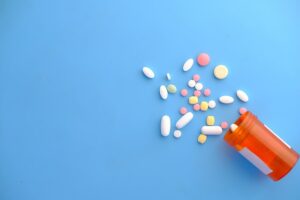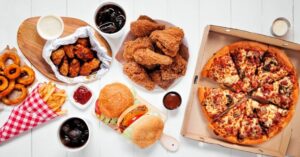Most people know that if you want to build muscle and gain strength, you need to eat more calories than you burn.
Of course, most people also know that this is going to make them gain body fat.
And it’s here that most people shy away from bulking.
Luckily, it is possible to bulk without gaining excessive amounts of body fat . . . if you know what you’re doing.
“Lean bulking” is a form of bulking that tightly regulates your calorie and macronutrient intake, so the majority of the weight you gain is muscle, not fat.
It’s basically just “smart” bulking—focusing on long-term muscle gain while keeping body fat levels fairly low instead of trying to gain as much weight (muscle and fat) as possible in the short-term.
In this article you’ll learn what lean bulking is and how to lean bulk correctly, including how to calculate your lean bulk calories and macros, what foods to include in your diet for lean bulking, what a good lean bulking meal plan looks like, how to use a lean bulk calculator, and more!
What Is a Lean Bulk?
Bulking is a method of dieting that involves temporarily maintaining a calorie surplus to maximize the amount of muscle and strength you can gain.
Bulking is necessary because how much food you eat (energy balance) strongly affects muscle growth. Put simply: your body’s “muscle building machinery” runs best when energy is abundant, so if you don’t eat enough calories every day, you’ll struggle to get bigger and stronger.
When you restrict your calories for fat loss, you won’t gain much muscle or strength because muscle protein synthesis rates drop, hormones sour, and workout performance suffers. (That is, unless you’re new to resistance training.)
Thus, if you want to build muscle effectively, you need to make sure you’re not consistently in a calorie deficit, even if it’s slight. Instead, you want to do the opposite: regularly feed your body slightly more energy than it burns (provide it with a “calorie surplus”).
You can roughly divide bulking into two schools of thought:
- Traditional or “dirty” bulking, which involves gaining weight as quickly as possible by eating as much food as you can stomach, regardless of its calorie content or macronutrient value. (Some also call this a “see food” diet.)
- Lean, or “clean” bulking, which involves regulating the number of calories and the type of foods you eat so that the majority of the weight you gain is muscle, not fat.
You’ll learn more about what lean bulking entails in a moment, but the long story short is that you maintain a small-to-moderate calorie surplus instead of eating as much as your heart desires. As a result, you gain weight and strength slower, but a much larger percentage of the weight you gain is muscle instead of fat.
Find the Best Diet for You in Just 60 Seconds
How many calories should you eat? What about “macros?” What foods should you eat? Take our 60-second quiz to get science-based answers to these questions and more.
Take the Quiz
The Problem with “Dirty” Bulking
Many people who are new to working out (especially young guys) opt for “dirty” bulking because . . .
- It requires less precision and discipline than lean bulking.
- It allows you to eat as much food as you like with no restrictions on the types of food or number of calories you consume, so you can go hog wild at meal times.
- It’s often espoused by bloggers, Youtubers, and other “influencers” who say it’s the best way to bulk up fast.
In other words, “dirty” or traditional bulking is more enjoyable in the short term, especially if you’re feeling famished and weak after a long cut, but it inevitably leads to rampant overeating and fat gain.
This is because no matter how much you eat, your body can only gain muscle so fast—you can’t force your muscles to grow faster by eating more calories. Instead, the extra calories are simply stored as body fat.
Many people who follow this approach believe that they’re gaining lots of muscle, but in reality they often gain much more body fat than lean mass.
While some people brush this problem aside (“you can always diet off the fat later”), it’s a mistake for several reasons. As I explain in my fitness book for men, Bigger Leaner Stronger:
Overeating too often when lean gaining causes you to gain fat too quickly, forcing you to start a cutting phase earlier than you’d like, before you were able to gain much muscle or strength. This mistake particularly impedes more experienced weightlifters who can’t gain size or strength when cutting and need to spend at least six-to-nine months of the year lean gaining to make significant improvements in their body—an impossible task if they don’t control their eating.
What’s more, gaining fat too quickly can cause motivation to wane (the process becomes less fun when your abs are replaced by flab) and may impair insulin sensitivity, making building muscle and burning fat more difficult.
In other words, dirty bulking causes you to gain more fat than is necessary without resulting in extra muscle gain, and alters your physiology in ways that make achieving your long-term body composition goals more difficult.
Thus, the smarter option is lean bulking.
When you follow a lean bulking diet you cap your calorie surplus at 5-to-10% more calories than you burn.
Research shows that this is the “sweet spot” for goosing muscle gain while minimizing fat gain. Eating more than this will only cause you to gain more fat, not muscle.
How to Lean Bulk
The essence of proper lean bulking is calculating your lean bulk calories and macros. I’m going to show you exactly how in a moment, but if you’d prefer to skip all the number crunching, take the Legion Diet Quiz instead.
All you have to do is answer 9 simple questions and in just 60 seconds you’ll learn exactly how many calories, how much of each macronutrient, and which foods you should eat to lean bulk successfully. Click here to check it out.
And if you’d like to learn more about the methodology behind this quiz and do the math yourself, read on!
Calculate Your Lean Bulk Calories
The sweet spot for maximizing muscle gain while minimizing fat gain is somewhere around 110% of your total daily energy expenditure.
This means that you can gain almost as much muscle (but a lot less fat) eating 10% more calories than you burn every day as you can eating 20 or 30% more.
For most people, maintaining a calorie surplus of 10% means consuming 16-to-18 calories per pound of body weight per day.
More specifically . . .
- If you’re lightly active (1-to-3 hours of exercise or vigorous activity per week), start with 16 (and try to do at least three strength training workouts per week).
- If you’re moderately active (5 or more hours of exercise or vigorous activity per week), go with 17, and then if you aren’t steadily gaining weight and strength, move up to 18.
- If you’re highly active (7-to-10+ hours of exercise or vigorous activity per week) use this total daily energy expenditure calculator to determine how many calories you should eat when lean bulking.
Oh, and if you’re sedentary (no exercise or vigorous activity), you shouldn’t be lean gaining because extra calories without resistance training just makes you fatter.
Calculate Your Lean Bulk Macros
In addition to eating the right number of calories, it’s also important that you eat the right amount of protein, fat, and carbs (“macros”) while lean bulking.
Here’s how to calculate your macros for a lean bulk:
- Protein: Eat 0.8-to-1 gram of protein per pound of body weight per day. This is enough to maximize muscle growth—eating more than this won’t help you bulk up faster. That said, there’s also nothing wrong with eating more than this, and some evidence shows that following a very-high protein diet (1.5-to-2 grams per pound) while bulking may help minimize fat gain. This usually works out to around 20-to-30% of calories for most people.
- Fat: Eat around 20-to-30% of your calories from fat. This is enough to optimize health and add flavor to your lean bulk meals, while still leaving plenty of room for protein and carbs.
- Carbs: Get the rest of your calories (~40-to-60%) from carbs. The reason you want to follow a high-carb diet while lean bulking is that this keeps your glycogen levels topped off, which improves your performance in the gym and positively impacts genes related to muscle growth.
FAQ #1: What are the best lean bulk foods?
One of the best ways to stick to your lean bulk diet plan is to stock up on your favorite lean bulking foods so you’ve always got something to hand come mealtime. Here are some of my favorites:
Lean Proteins for Bulking
- Sirloin steak
- Ground beef
- Pork tenderloin
- Chicken breast
- Seafood (especially low-fat fish like tilapia, cod, catfish, etc.)
- Egg whites
- Chickpeas
- Greek yogurt or Skyr
- Cottage cheese
- Low-fat milk
Healthy Carbs for Bulking
- Quinoa
- White or brown rice
- Sweet potatoes
- Whole grain pasta
- Ezekiel bread
- Potatoes
- Oats
- Granola
- Broccoli
- Spinach
Healthy Fats for Bulking
- Avocados
- Whole eggs
- Olive oil
- Almonds or almond butter
- Peanuts or peanut butter
- Pistachios
- Coconut oil
- Walnuts
- Chia seeds
- Cashews
FAQ #2: What’s the best lean bulk calculator?
A lean bulk calculator is a macronutrient calculator that’s configured to calculate your macros for lean bulking.
You can change the Legion Macronutrient Calculator into a lean bulking calculator by inputting your data then selecting “Moderate weight gain (1% of body weight per month)” or “Rapid weight gain (2% of body weight per month)” from the “Goal” dropdown box.
FAQ #3: What’s the best lean bulk meal plan?
There’s no such thing as a lean bulking meal plan that’s “best” for everyone because everyone’s calorie and macronutrient needs are different.
That said, to lean bulk successfully, your lean bulk meals should . . .
- Put you in a daily calorie surplus of around 10%
- Primarily comprise whole, nutritious, minimally processed foods
Here’s an example of how that might look for a 180-pound man:
FAQ #4: What’s the best lean bulk workout plan?
If you want to follow a lean bulk workout plan that’s specifically designed to work with the bulking information in this article, then check out the workout plans in my best-selling fitness books Bigger Leaner Stronger for men, and Thinner Leaner Stronger for women.
FAQ #5: What does a successful lean bulk before and after look like?
If you want to see significant results from lean bulking, you need to do it more than once.
That is, you’ll need to alternate between lean bulking phases where you focus on adding muscle mass to your frame (along with some fat) and cutting phases to strip away any extra fat while retaining your newly gained muscle.
This is the method I teach in my fitness books Bigger Leaner Stronger for men, and Thinner Leaner Stronger for women, and it’s the method these folks used to dramatically change their bodies over the course of 12 months:
+ Scientific References
- Iraki, J., Fitschen, P., Espinar, S., & Helms, E. (2019). Nutrition Recommendations for Bodybuilders in the Off-Season: A Narrative Review. Sports, 7(7). https://doi.org/10.3390/SPORTS7070154
- Dyck, D. J., Heigenhauser, G. J. F., & Bruce, C. R. (2006). The role of adipokines as regulators of skeletal muscle fatty acid metabolism and insulin sensitivity. Acta Physiologica (Oxford, England), 186(1), 5–16. https://doi.org/10.1111/J.1748-1716.2005.01502.X
- Rohrmann, S., Shiels, M. S., Lopez, D. S., Rifai, N., Nelson, W. G., Kanarek, N., Guallar, E., Menke, A., Joshu, C. E., Feinleib, M., Sutcliffe, S., & Platz, E. A. (2011). Body fatness and sex steroid hormone concentrations in US men: results from NHANES III. Cancer Causes & Control : CCC, 22(8), 1141–1151. https://doi.org/10.1007/S10552-011-9790-Z
- Zhang, J., Hupfeld, C. J., Taylor, S. S., Olefsky, J. M., & Tsien, R. Y. (2005). Insulin disrupts β-adrenergic signalling to protein kinase A in adipocytes. Nature 2005 437:7058, 437(7058), 569–573. https://doi.org/10.1038/nature04140
- Garthe, I., Raastad, T., Refsnes, P. E., & Sundgot-Borgen, J. (2013). Effect of nutritional intervention on body composition and performance in elite athletes. European Journal of Sport Science, 13(3), 295–303. https://doi.org/10.1080/17461391.2011.643923
- Iraki, J., Fitschen, P., Espinar, S., & Helms, E. (2019). Nutrition Recommendations for Bodybuilders in the Off-Season: A Narrative Review. Sports, 7(7). https://doi.org/10.3390/SPORTS7070154
- Forbes, G. B., Brown, M. R., Welle, S. L., & Lipinski, B. A. (1986). Deliberate overfeeding in women and men: energy cost and composition of the weight gain. The British Journal of Nutrition, 56(1), 1–9. https://doi.org/10.1079/BJN19860080
- Antonio, J., Peacock, C. A., Ellerbroek, A., Fromhoff, B., & Silver, T. (2014). The effects of consuming a high protein diet (4.4 g/kg/d) on body composition in resistance-trained individuals. Journal of the International Society of Sports Nutrition, 11(1), 1–6. https://doi.org/10.1186/1550-2783-11-19/COMMENTS
- Antonio, J., Ellerbroek, A., Silver, T., Orris, S., Scheiner, M., Gonzalez, A., & Peacock, C. A. (2015). A high protein diet (3.4 g/kg/d) combined with a heavy resistance training program improves body composition in healthy trained men and women – a follow-up investigation. Journal of the International Society of Sports Nutrition, 12(1), 1–9. https://doi.org/10.1186/S12970-015-0100-0/TABLES/7
- Coyle, E. F. (1995). Substrate utilization during exercise in active people. The American Journal of Clinical Nutrition, 61(4 Suppl). https://doi.org/10.1093/AJCN/61.4.968S











